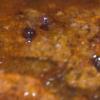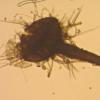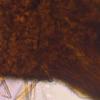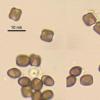
20-12-2025 23:08
Patrice TANCHAUDBonsoir, récolte sur sol sablonneux dans l'arri�

20-12-2025 15:47
Mirek GrycHi.These grew on pine wood that was heavily covere

18-12-2025 21:17
Pol DebaenstThe identification took me to Byssonectria deformi

15-12-2025 07:09
 Danny Newman
Danny Newman
indet. Rutstroemiaceae sp. on unk. fallen leavesMc

19-12-2025 10:10
Patrice TANCHAUDBonjour, récolte réalisée en milieu dunaire, a

18-12-2025 17:23
 Bruno Coué
Bruno Coué
Bonjour,je serais heureux d'avoir votre avis sur c

18-12-2025 18:07
Margot en Geert VullingsThese plumes were found on rotten wood.They strong

17-12-2025 18:35
 Michel Hairaud
Michel Hairaud
Bonjour à tous/Hi to everyone I am passing along
Interesting Perithecia from leaves of Ledum palustre
Nina Filippova,
20-06-2014 13:49
Coordinates: N60,891352° E68,690042°, 16.06.2014.
Perithecia on lower side of the leaf, scattered, submerged under epidermis with protruding neck, up to 400 mk high, perithecium about 150 mk in diameter, neck about 30-40 mk broad, with collar up to 100 mk.
Outer peridium from brown angular cells, covered with outgrowing hyphoid brown setae up to 200 mk long, 7 mk broad at base; neck covered by parralel brown hyphae 3-4 mk broad, in upper part of the neck these hyphae create rosette; spores cubical, about 6.7 x 6.3 mk, with thin wall on two opposite sides.
Paul Cannon,
20-06-2014 14:03
Re : Interesting Perithecia from leaves of Ledum palustre
This is a species of Scopinella - possibly S. solani but it's a long time since I worked on them. They are ascospores rather than conidia - the asci deliquesce at an early stage.
Nina Filippova,
20-06-2014 14:39
Re : Interesting Perithecia from leaves of Ledum palustre
Thank you, Paul. I will look later in literature for exact identification.
Nina.
Nina.
David Malloch,
20-06-2014 15:13

Re : Interesting Perithecia from leaves of Ledum palustre
Hi Nina,
This may be S. barbata Lév.
My notes say:
"Growing on decaying oak leaves in Europe and Algeria. Asci 8-spored. Ostiolar hyphae extending well beyond the fused portion of the neck and forming a basket-like arrangement holding spores. Lateral hairs of the ascomata not spine-like and fused in groups of only 2 or 3. Spores more than 5-6um long"
It may not be restricted to oak leaves; there are probably not enough reports of this species in the literature to be sure about substrate-specificity.
Dave
This may be S. barbata Lév.
My notes say:
"Growing on decaying oak leaves in Europe and Algeria. Asci 8-spored. Ostiolar hyphae extending well beyond the fused portion of the neck and forming a basket-like arrangement holding spores. Lateral hairs of the ascomata not spine-like and fused in groups of only 2 or 3. Spores more than 5-6um long"
It may not be restricted to oak leaves; there are probably not enough reports of this species in the literature to be sure about substrate-specificity.
Dave




